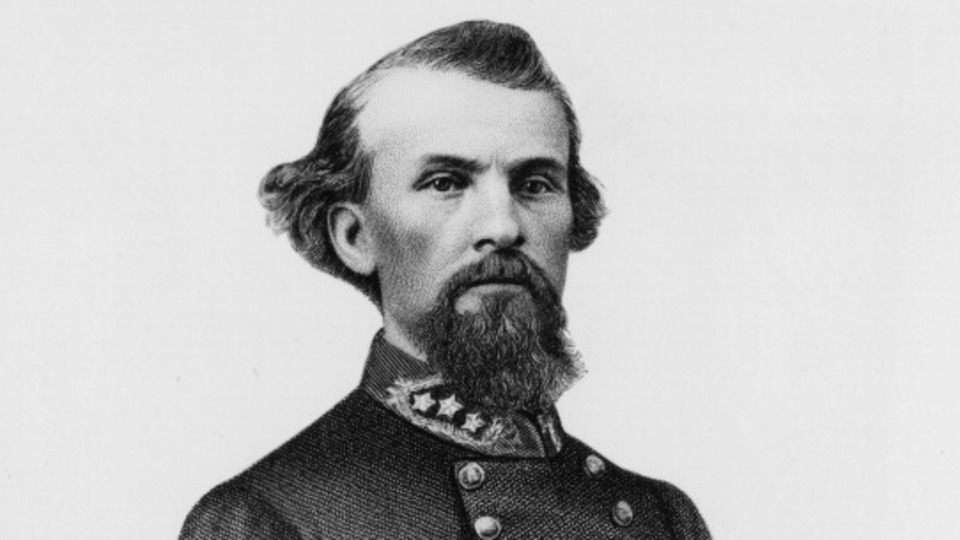Nathan Bedford Forrest was not a man that Samuel Montgomery wanted his niece to marry. In the early 1840’s when this young Tennessean appeared in Hernando, Mississippi to court Mary Ann Montgomery, her Uncle Sam tried to discourage him. Mary Ann’s father had died and Samuel, a Presbyterian minister, was her closest male guardian, and no Christian would have wanted their loved one mixed up with Forrest. “Nathan, you don’t want to marry Mary Ann. She’s a sweet Christian girl and you curse and gamble.” Nathan replied, “I know she’s a sweet, Christian girl…that’s why I want to marry her.” A “Christian” Forrest was not, but a protective and chivalrous man, he could be.
Mary Ann and her mother were on their way home one day when they got their horse and wagon stuck in a creek. While two young men sat laughing at them on the creek bank, another young man rode up into the creek on his horse, dismounted, carried the ladies to safety, and then pushed their wagon out of the creek. He then walked over to the young “no goods” and told them to stop laughing and move on or he would give them both a thrashing. They fled, and the “good Samaritan” went back and introduced himself to the damsels in distress. His name was Nathan Bedford Forrest, and he desperately wanted to see Mary Ann again.
The next week, Forrest rode out to the Montgomery place and began his quest to win the hand of Mary Ann. He promised her family that they would never have to worry about her safety because he would take good care of her. Six weeks later they were married and living their life in Mississippi.
Forrest must have seemed an odd match for the angelic Mary Ann Montgomery. Though raised by a Christian mother, Nathan was anything but a Christian himself. His father had died when he was 16, thus making him the “man of house” with a mother and ten younger siblings to care for. But Nathan arose to the challenge. He ran the family farm with a keen eye and a firm hand, and protected his family honorably. Life on the Tennessee frontier was rough and dangerous, proven by the fact that one day Nathan’s mother came home covered in blood having been attacked by a cougar. Nathan grabbed his gun and whistled at his two hunting dogs and off they went. He tracked and stalked the cougar until his dogs had it treed…..then waited until morning to get a clean shot. He cut off its ears and gave them to “Momma” as a trophy.
When Nathan was young, he killed his first man. He was staying with his 65-year-old uncle when the four Matlock brothers, who were owed money by the elder Forrest, came calling. When they attacked, so did twenty-four year-old Nathan. He shot two of the brothers with a pistol, and stabbed the other two with a knife that was thrown to him by a witness during the brawl. Four Matlock brothers walked into the room that day to fight it out with “Old Man Forrest.” Three of them never walked back out, and one survived to tell the story. Even back then, Nathan Bedford Forrest was not a man to be trifled with.
Nathan went on to become a very successful and wealthy businessman. Though uneducated and “backwoods” by nature, he was a skilled entrepreneur, albeit in an immoral trade. He made his fortune as a slave trader and as a plantation owner, and by the time the Civil War began in 1861, he was worth 1.5 million dollars, an astronomical figure, when considered by today’s standards. When his home state of Tennessee and his adopted home state of Mississippi both seceded from the Union, Nathan understandably sided with them. He enlisted along with his younger brother and his 15-year-old son Willie; and was made a Private in the Cavalry. By war’s end he would be a Lieutenant General, the only man to go from Private to Lieutenant General during the Civil War.
In 1861, Forrest was promoted to Lieutenant Colonel and given the charge to raise a Cavalry regiment. He did so and soon garnered a reputation as the most skilled Cavalry man the Civil War would produce. Though completely untrained in military tactics, his natural instincts were uncanny, and he was an absolute nightmare to the Union destroying railroads, communications lines, and supply lines. William Tecumseh Sherman declared that Tennessee would never be safe as long as “that devil Forrest” was a live and that they had to kill him “even if it takes 10,000 men and bankrupts the Federal treasury.” Fierce in battle, Forrest would kill 31 men in hand to hand combat, and have 30 horses shot out from under him during the course of the war. He rightly joked that he ended up “one horse ahead” by war’s end. It was said that Ulysses S. Grant claimed to fear no man on earth….except Nathan Bedford Forrest. Once in a fierce battle, while encircled by Union troops, Forrest began running straight for a Union supply wagon, which he then jumped and escaped capture. Another time he was personally fighting four Union soldiers at one time, all of them intent on making their name famous for “killing Forest.” He whipped them all, and yet again managed to escape.
Forrest employed many clever tactics throughout the war. When traveling with his Cavalry, he would determine where the Union spies were observing his men, then he would have his men peel off, backtrack, and ride again in circles past the observation point, thus giving the appearance of having thousands of men, when in fact he had mere hundreds. Then he would send a rider under a flag of truce and tell the Union troops that they were hopelessly outnumbered and must surrender or face the sword. By doing so, he captured scores of Union troops without firing a shot. But eventually his bluff was called and the results were dreadful and controversial, both then and now. At a location on the Mississippi River called Fort Pillow, Forrest ordered a Union regiment to surrender with the promise of honorable treatment as prisoners of war, or to be attacked and likely killed. The Union commander at the time was Major William Bradford, who was a “Tennessee Yankee” from Bedford County, ironically the county of Forrest’s birth, and the county from which he got his middle name. Bradford was seen as a traitor to many of his fellow Tennesseans, and was certainly not a man Forrest respected. Undoubtedly Forrest’s legendary temper played a part as he ordered the Fort charged having concluded the bloodshed was to be laid at the feet of Bradford, a traitor who refused to surrender against overwhelming numbers.
What happened next is disputed and fuzzy. Clearly in the heat of battle there were surrendering soldiers wrongly shot on sight. Fort Pillow being made up of white soldiers seen as traitors, along with 300 black soldiers didn’t gain a lot of sympathy from Forrest’s men. It was called a massacre, and in many ways it appeared to be. Forrest arrived in the Fort twenty minutes after it was overtaken by Confederates and immediately rode his horse between the two sides with saber and pistol drawn ordering a cease-fire. But the damage was done. Forrest would forever be remembered as the man who ordered the massacre of Fort Pillow, though a Congressional hearing by the Union army would eventually find him personally innocent of wrong doing. He was hated and feared that much more by the Northern people.
The war would rage on for another year with Forrest’s army trying to distract Sherman in his march to Georgia and the sea. Eventually it became clear that the cause was lost, and after both Robert E. Lee and Joseph Johnston surrendered Forrest saw the handwriting on the wall. Forrest told his men, “any man who is in favor of a further prosecution of this war is a fit subject for a lunatic asylum.” Forrest surrendered, and went to be reunited with his wife in Tennessee.
Nathan Bedford Forrest, who was worth 1.5 million dollars in 1861, was now broke. The only money to be found was $10 that his dutiful wife had saved for a rainy day. Forrest sought to take the money to a poker game and increase it, but his wife begged him not to stating that it would be immoral and a sin against God. He asked his wife if she would consent to pray for him as he played poker, so that their money might increase. She refused, but Forrest went to the poker game anyway. That night he returned with $1500, though his wife was unimpressed.
Forrest’s post-war life further soiled his reputation. As Reconstruction commenced in the South, many Southerners resentfully fought against the Northern “carpet baggers” who came down, collected government contracts worth millions, then did little to fulfill obligations. Tensions were high between Northerners, Southerners, and many freed slaves. In 1867 a group of white men in Pulaski, Tennessee formed a group that was meant to be a “protective” squad for Southerners that they dubbed the Ku Klux Klan. A year and a half later, Forrest became a member and was promptly elected as their first “Grand Wizard” thus forever cementing his reputation as the epitome of Southern racism. In 1868, after Tennessee’s pro-Union Governor William Brownlow was defeated at the polls, Forrest resigned from the Klan and urged their disbanding saying their purposes had been fulfilled. His urgings were ignored and the Klan set off on a violent streak of atrocities that would cause them to live forever in infamy. They would eventually disband, only to be re-chartered in 1915 with an even more violent and racist agenda. But the story of Nathan Bedford Forrest doesn’t end with the Civil War, Fort Pillow, or the KKK. As Paul Harvey would say…. “Have you heard the REST of the story?”
Nathan Bedford Forrest had been raised by a godly Mother to be a man of hard work and honor. Though he did not adopt his Mother’s faith, he held a reverence for Christians throughout his life. Chapel services were encouraged in his army, and General Forrest frequently attended. And though Forrest was famous for his profanity when in the midst of a tirade, his speech was relatively clean when he was calm, and he abhorred “smutty or vulgar talk” as being disrespectful towards women. Forrest never drank alcohol, nor used tobacco in any form. And he was absolutely devoted to his wife Mary Ann, declaring on many occasions that it was because of the prayers of his wife and mother that he had lived through so many fierce battles. When enraged, it was said that Forrest’s face would glow so bright red that he appeared to be a different person. Yet it was also said that his Godly wife could calm him down with only a word. He forever adored, respected, and revered her.
As Fort Donelson was falling to U.S. Grant in 1864, Forrest called his second in command, a former Methodist minister named Major D.C. Kelly to his side and implored him, “For God’s sake Parson, Pray! Only God Almighty could save that Fort now.” And as the war, and his eventual capture and death seemed likely, Forrest wrote a letter to his only son Willie imploring him to take good care of his mother and to be careful not to emulate his sinful and wicked ways. Forrest was glad to have Christians in his family, but he confessed that he considered Christianity to be “a woman’s religion.” But all of that changed in the mid 1870’s.
Though Forrest was only in his 50’s, a lifetime of hard living and battle were beginning to take their toll on him. He began attending church with his beloved wife at the Court Avenue Presbyterian Church in Memphis where the gospel was preached faithfully by Rev. George Stainback. And he began to feel the Holy Spirit’s conviction for a lifetime of sin. One day he ran into an old army buddy who had been under his command named Raleigh White. Forrest exclaimed, “Why, Raleigh White, its you! I heard you’d gone down to South America or somewhere!” White replied that this was not true, but that he had in fact become a Christian, having been led to Christ by his wife after the war. After trying his hand in business, White succumbed to an overwhelming call to preach the gospel of Christ to sinners; and was now a Southern Baptist Pastor living in Texas. Forrest listened to White’s testimony with obvious excitement, and then asked White if he would pray for him. The two veterans went into a bank lobby and knelt together as White prayed for Forrest. Then they parted ways. Another gospel seed had been planted that would soon take permanent root.
In the Fall of 1875, Forrest found himself setting next to his wife listening to Rev. Stainback preach from Jesus’ words in Matthew 7:
“Therefore everyone who hears these words of Mine and acts on them, may be compared to a wise man who built his house on the rock. And the rain fell, and the floods came, and the winds blew and slammed against that house; and yet it did not fall, for it had been founded on the rock. Everyone who hears these words of Mine and does not act on them, will be like a foolish man who built his house on the sand. The rain fell, and the floods came, and the winds blew and slammed against that house; and it fell—and great was its fall.” (Matthew 7:24-27 NASB)
Forrest’s heart was crushed and his spiritual eyes were opened. After the service he pulled Rev. Stainback aside and as Rev. Stainback later recounted: “Forrest suddenly leaned against the wall and his eyes filled with tears. ‘Sir, your sermon has removed the last prop from under me,’ he said, ‘I am the fool that built on the sand; I am a poor miserable sinner.” Stainback told Forrest to go home and read and meditate on Psalm 51 and see where it led him.
“Be gracious to me, O God, according to Your lovingkindness; According to the greatness of Your compassion blot out my transgressions. Wash me thoroughly from my iniquity And cleanse me from my sin. For I know my transgressions, And my sin is ever before me.” (Psalms 51:1-3 NASB)
The next night, Rev. Stainback went by to visit with Forrest, and they fell to their knees and prayed together. Forrest said that he had put his trust in the Redeemer, and that his heart was finally at peace. The final two years of his life seemed to bear out the truth of his confession. Nathan Bedford Forrest the fierce fighter, gambler, racist, and sinner….was a changed man.
In 1875, Forrest was invited to speak to a black civil rights group called the “Pole-Bearers” Association, a forerunner for today’s NAACP. Though mocked by some white people for appearing, Forrest addressed the black people in love saying, “I came here with the jeers of some white people, who think that I am doing wrong. I believe I can exert some influence, and do much to assist the people in strengthening fraternal relations, and shall do all in my power to elevate every man, to depress none. I want to elevate you to take positions in law offices, in stores, on farms, and wherever you are capable of going. I came to meet you as friends, and welcome you to the white people. I want you to come nearer to us. When I can serve you I will do so. We have but one flag, one country; let us stand together. We may differ in color, but not in sentiment. Many things have been said about me which are wrong, and which white and black persons here, who stood by me through the war, can contradict. Go to work, be industrious, live honestly and act truly, and when you are oppressed I’ll come to your relief. I thank you, ladies and gentlemen, for this opportunity you have afforded me to be with you, and to assure you that I am with you in heart and in hand.”
At the end of his speech a young, black girl named Lou Lewis presented General Forrest with a bouquet of flowers as a sign of reconciliation between the two races. Forrest accepted the flowers, then leaned down and gently kissed the girl on the cheek, a public act of reverence and respect that was absolutely unheard of for a white man to do in that day. Indeed, Nathan Bedford Forrest, former Grand Wizard of the KKK, was a new creature in Christ.
Nathan Bedford Forrest died from complications from Diabetes on October 21, 1877, when he was 56 years old. He said on his deathbed that there was “not a cloud that separated him from his beloved Heavenly Father.” The lessons from the life of Nathan Bedford Forrest are legion. His battlefield tactics have been studied by military men the world over, and he has been called by many a strategic genius in the art of war. But his personal and spiritual life give us far greater lessons. He is a clear testimonial example of God’s overwhelming power to change even the hardest of sinners. Though sadly, Forrest today is mostly remembered for his sin.
Many efforts have been made by civil rights leaders to have his name removed from parks and schools all across the South because of his being the epitome of racism. And yet, when the complete story of Nathan Bedford Forrest is known, we see him as being the very example of what we would hope to see from all racial bigots: a transformed and changed life. Though he was once the black man’s enemy, he became one of their dearest friends and defenders. His desire to see black people serving in politics and professional occupations was a clarion call for equality that was way ahead of its time. In fact, this “Southern racist” called for greater civil rights than most Northern abolitionists would have been comfortable with. Forrest had once owned and sold slaves for his business. Now his business was to see that they were treated fairly. It reminds me of another slave-trader turned Christian by the name of John Newton, who wrote a hymn you might have heard of: “Amazing Grace! How sweet the sound that saved a wretch like me! I once was lost, but now am found; was blind, but now I see.”
To hold a grudge against Nathan Bedford Forrest is to deny one of the greatest truths Christ teaches us; that the power of the gospel can change anyone. And that we should ask the Lord to “forgive us our sins, as we forgive those who sin against us.” (Matthew 6:12) Nathan Bedford Forrest was a sinner par excellence. So am I. And so are you, if you would be humble enough to admit it. For the Bible teaches us that “all have sinned and fallen short of the glory of God.” (Romans 3:23) Nathan Bedford Forrest was despised in his day, as he is in most circles today, though Christians should forgive him just as Christ has forgiven us. Union General William T. Sherman vowed to catch “that devil Forrest.” But Sherman never was able to do it. In the end, it was Jesus Christ who finally caught up with him. And rather than kill him….Jesus changed him and on a glorious and providential day in 1875, the unthinkable and impossible actually happened: “that devil” got saved. Let us hope and pray that the Lord Jesus Christ would save many more “devils” like Nathan Bedford Forrest and transfer them from “the domain of darkness to the kingdom of His beloved Son.” (Colossians 1:13)
Editor’s Note: If you would like to find out why or how we should celebrate the tremendous faith of our theological heroes – in spite of our their sin, watch this clip from Albert Mohler. Although Mohler was applying this (implicitly) toward Martin Luther King – who never repented of his whoremongering, sex-trafficking, bi-sexuality, heresy or plagiarism, this is a fitting explanation for why we should rightly celebrate the faith of those heroes who did come to terms with their sin and eventually repent.
[Editor’s Note: This article was written by Shane E. Kastler, as a part of his greater book, Nathan Bedford Forrest’s Redemption. You can see this article at The Narrow Road here. You can also here Kastler’s sermon on this topic at SermonAudio here.]










